- Student Kaustubh Sreevathsan
- Code UAR22096
- Faculty Architecture
- Tutor/s Anuj Anjaria,Muntaha Rushnaiwala
- TA Dhruval Gadhvi
The design process began by taking inspiration from the instrumental piece “Can You Hear the Music” by Ludwig Goransson and integrating its interpretation with a deconstructed cube in order to give rise to a tangible, functional and spatially engaging concept. The design in its closed condition contains 4 identical units behaving as an introverted space, facilitating exclusive interactions. In its open condition, the roof rotates upwards, changing the quality of light and ventilation in the space whereas the hinged L-shaped spaces form corridors which increases the connectivity between the 4 units. When hinged outwards, it also creates a central courtyard which can be used for larger discussions, hence inducing an extroverted quality to the space. Whilst the cube provides a strong base to the design, the coalescence of the kinetic element and music adds a layer of intrigue and depth to the space. The design process began by taking inspiration from the instrumental piece “Can You Hear the Music” by Ludwig Goransson and integrating its interpretation with a deconstructed cube in order to give rise to a tangible, functional and spatially engaging concept. The design in its closed condition contains 4 identical units behaving as an introverted space, facilitating exclusive interactions. In its open condition, the roof rotates upwards, changing the quality of light and ventilation in the space whereas the hinged L-shaped spaces form corridors which increases the connectivity between the 4 units. When hinged outwards, it also creates a central courtyard which can be used for larger discussions, hence inducing an extroverted quality to the space. Whilst the cube provides a strong base to the design, the coalescence of the kinetic element and music adds a layer of intrigue and depth to the space.







